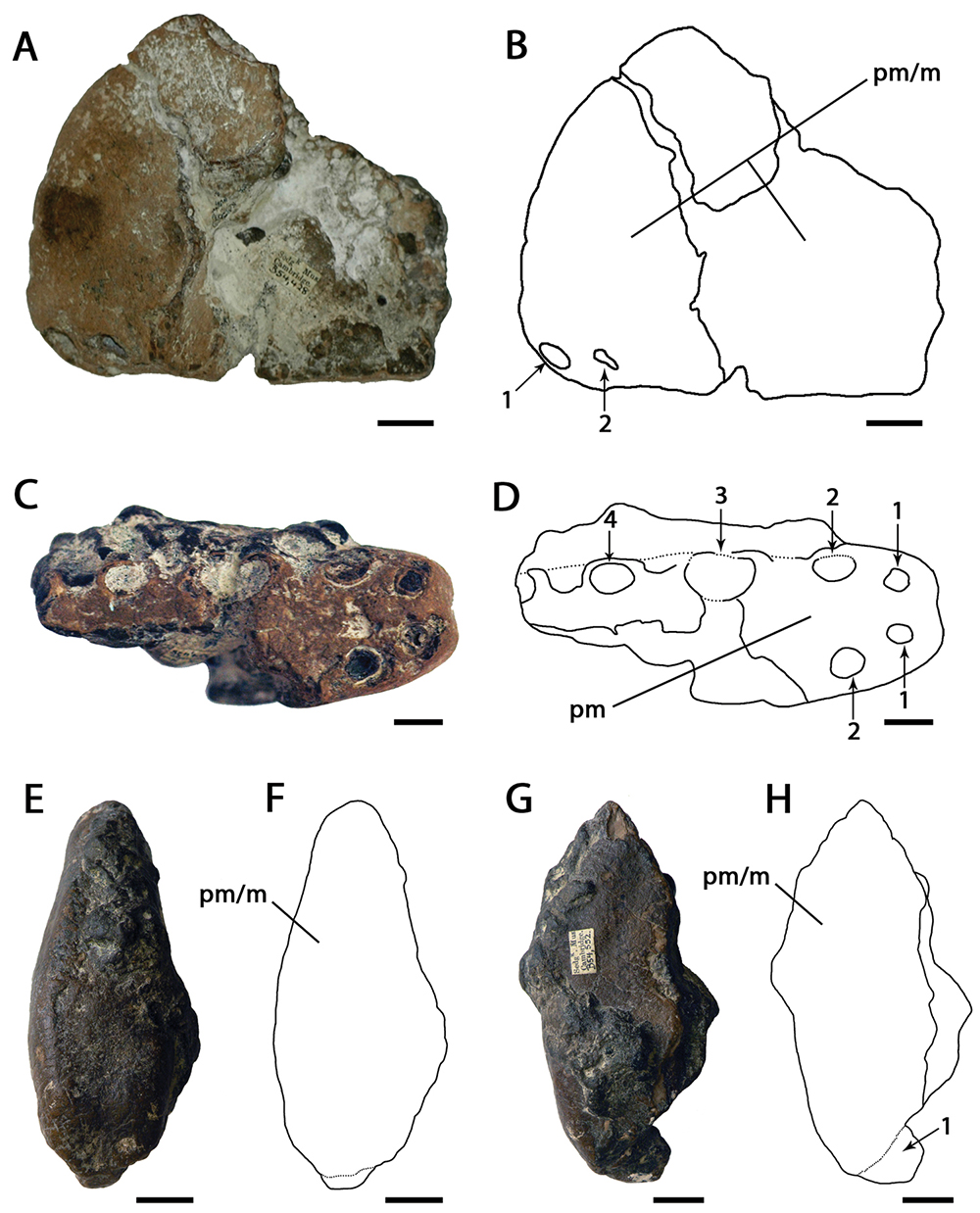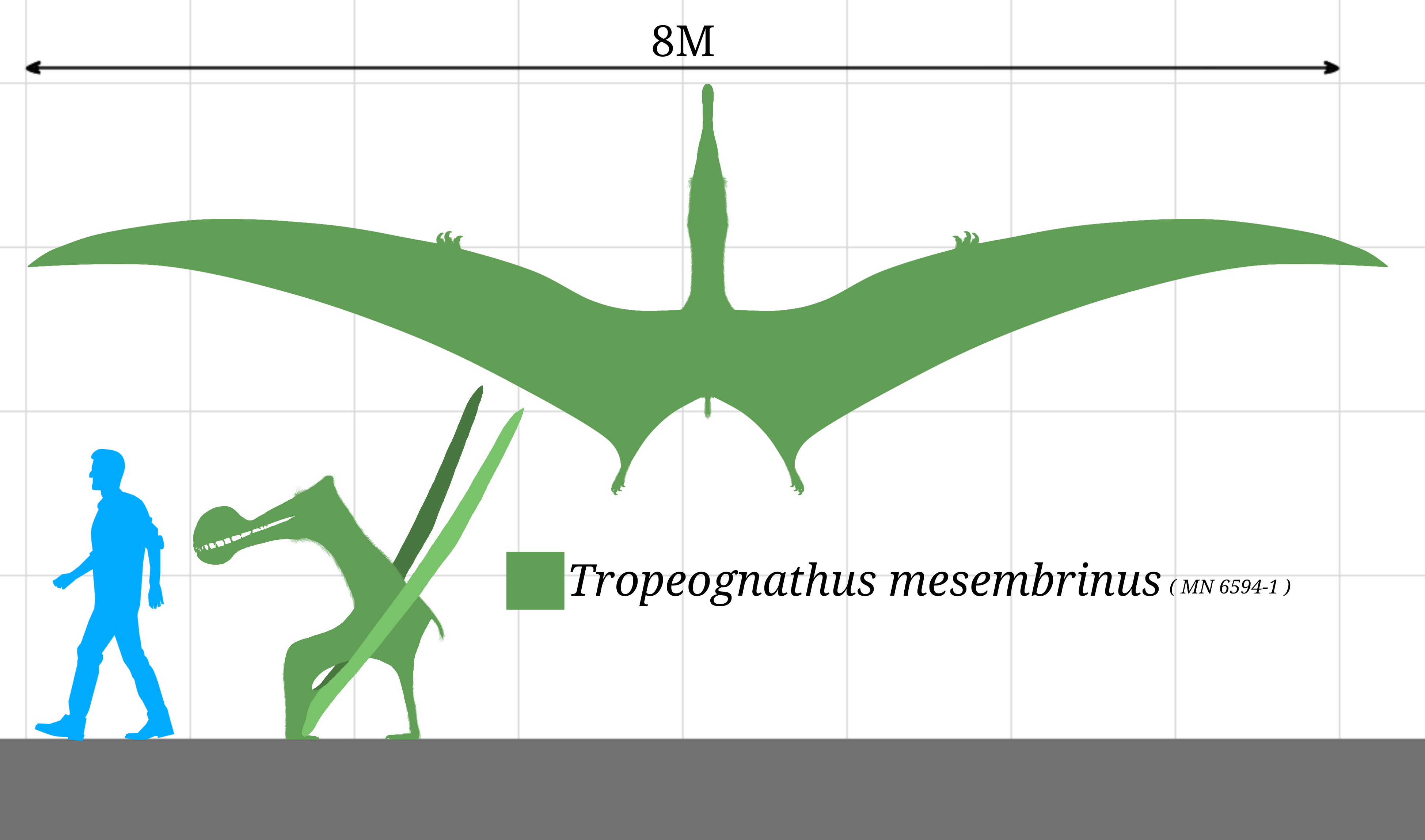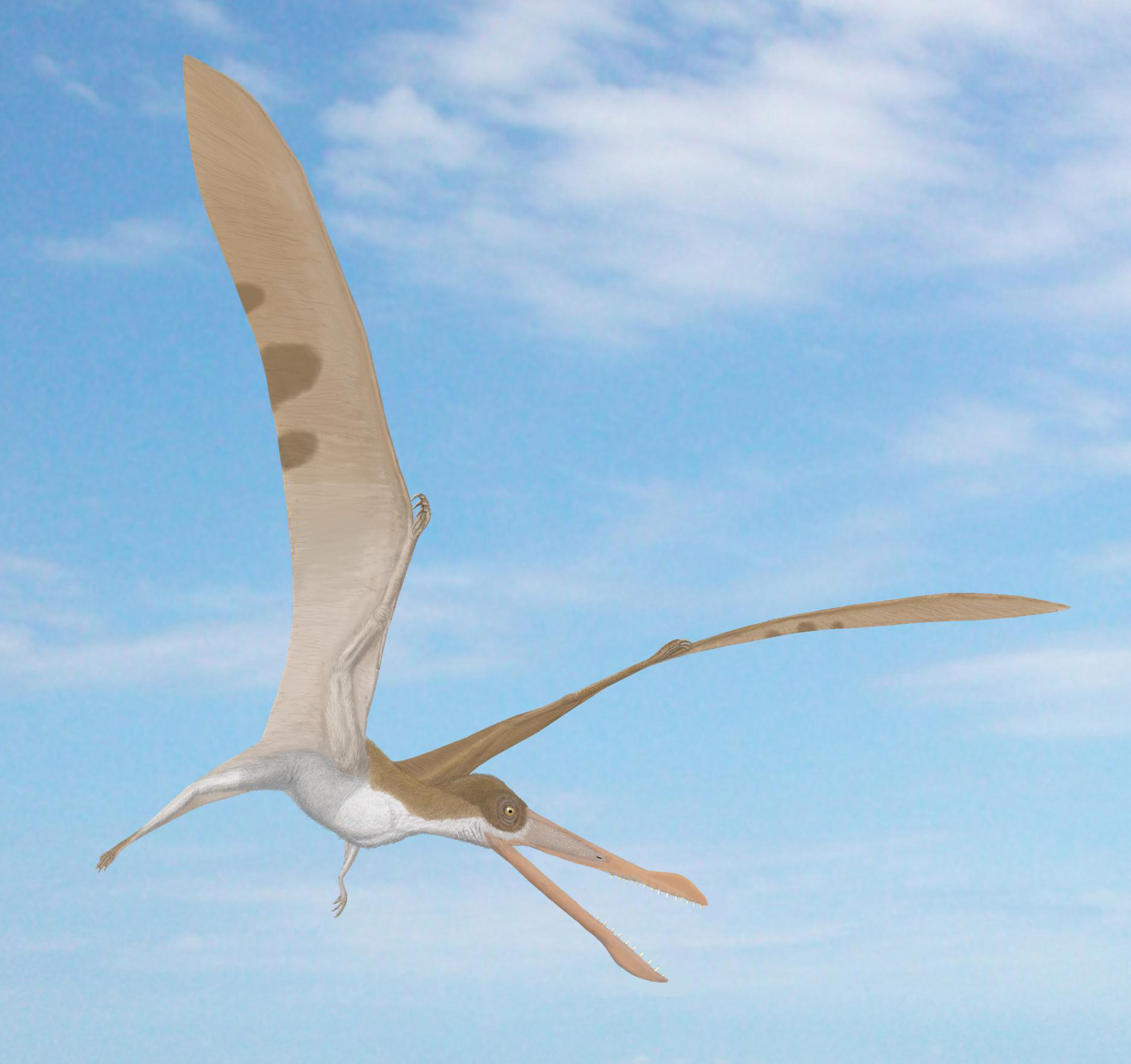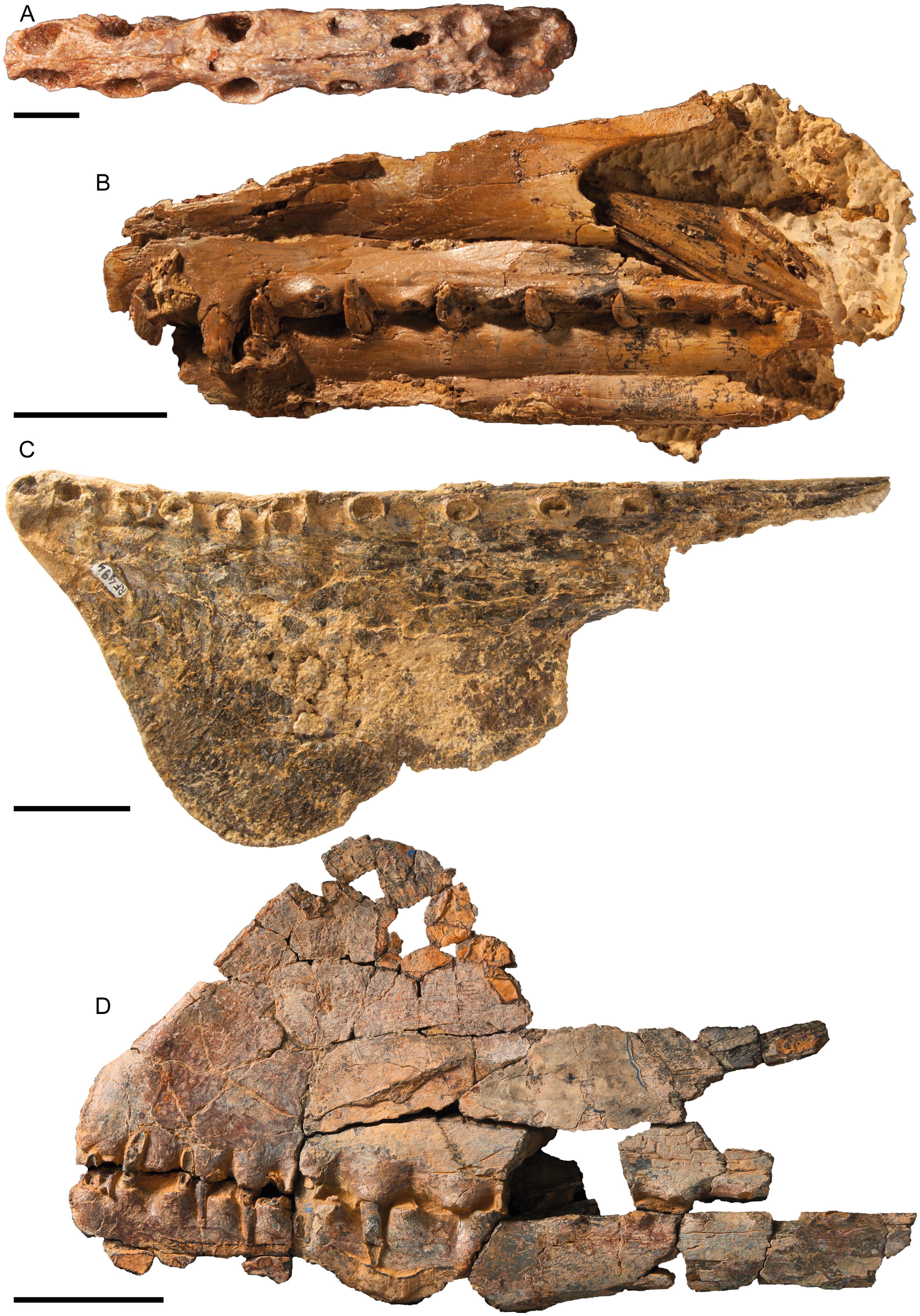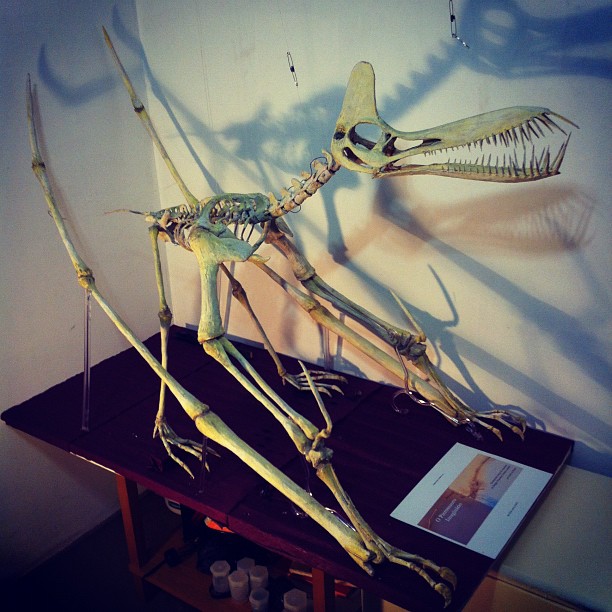|
Anhangueridae
Anhangueridae (alternatively called Ornithocheiridae, meaning "bird hands") is a group of pterosaurs within the suborder Pterodactyloidea. These pterosaurs were among the last to possess teeth. Members that belong to this group lived from the Early to Late Cretaceous periods (Valanginian to Turonian stages), around 140 to 90 million years ago. Anhanguerids are generally infamous for having an enormously controversial and very confusing taxonomy. Although agreements that these animals were related, and therefore similar to istiodactylids and pteranodontians, there is still no virtual consensus over the exact content and interrelationships of this group. Anhanguerids were the most successful pterosaurs during their reign, and were also the largest pterosaurs before the appearance of the azhdarchids such as ''Quetzalcoatlus''. Anhanguerids were excellent fish hunters, using various flight techniques to catch their prey, and were also capable of flying great distances without fla ... [...More Info...] [...Related Items...] OR: [Wikipedia] [Google] [Baidu] |
Tropeognathinae
Anhangueridae (alternatively called Ornithocheiridae, meaning "bird hands") is a group of pterosaurs within the suborder Pterodactyloidea. These pterosaurs were among the last to possess teeth. Members that belong to this group lived from the Early Cretaceous, Early to Late Cretaceous periods (Valanginian to Turonian stages), around 140 to 90 million years ago. Anhanguerids are generally infamous for having an enormously controversial and very confusing taxonomy. Although agreements that these animals were related, and therefore similar to istiodactylids and pteranodontians, there is still no virtual consensus over the exact content and interrelationships of this group. Anhanguerids were the most successful pterosaurs during their reign, and were also the largest pterosaurs before the appearance of the azhdarchids such as ''Quetzalcoatlus''. Anhanguerids were excellent fish hunters, using various flight techniques to catch their prey, and were also capable of flying great distan ... [...More Info...] [...Related Items...] OR: [Wikipedia] [Google] [Baidu] |
Tropeognathus
''Tropeognathus'' (meaning "keel jaw") is a genus of large pterosaurs from the late Early Cretaceous of South America. This genus is considered to be a member of the family Anhangueridae, however, several studies have also recovered it within another family called Ornithocheiridae. Both of these families are diverse groups of pterosaurs known for their keel-tipped snouts and large size. ''Tropeognathus'' is regarded as the largest pterosaur found in the Southern Hemisphere, only rivaled by the huge azhdarchids. The type and only species is ''Tropeognathus mesembrinus''. Fossil remains of ''Tropeognathus'' have been recovered from the Romualdo Formation, which is a Lagerstätte located in the Santana Group of the Araripe Basin in northeastern Brazil. Discovery and naming In the 1980s the German paleontology museum ''Bayerische Staatssammlung für Paläontologie und historische Geologie'' in Munich acquired a pterosaur skull from Brazilian fossil dealers that had probably been ... [...More Info...] [...Related Items...] OR: [Wikipedia] [Google] [Baidu] |
Tropeognathus Mesembrinus
''Tropeognathus'' (meaning "keel jaw") is a genus of large pterosaurs from the late Early Cretaceous of South America. This genus is considered to be a member of the family Anhangueridae, however, several studies have also recovered it within another family called Ornithocheiridae. Both of these families are diverse groups of pterosaurs known for their keel-tipped snouts and large size. ''Tropeognathus'' is regarded as the largest pterosaur found in the Southern Hemisphere, only rivaled by the huge azhdarchids. The type and only species is ''Tropeognathus mesembrinus''. Fossil remains of ''Tropeognathus'' have been recovered from the Romualdo Formation, which is a Lagerstätte located in the Santana Group of the Araripe Basin in northeastern Brazil. Discovery and naming In the 1980s the German paleontology museum '' Bayerische Staatssammlung für Paläontologie und historische Geologie'' in Munich acquired a pterosaur skull from Brazilian fossil dealers that had probabl ... [...More Info...] [...Related Items...] OR: [Wikipedia] [Google] [Baidu] |
Cearadactylus
''Cearadactylus'' is a genus of large anhanguerid pterodactyloid pterosaur from the Romualdo Formation of Brazil, South America. Fossil remains of ''Cearadactylus'' dated back to the Albian stage of the Early Cretaceous period, about 112 million years ago. The only known species is ''C. atrox'', described and named in 1985 by Giuseppe Leonardi and Guido Borgomanero. The name refers to the Brazilian state Ceará, and combines this with Greek ''daktylos'', "finger", a reference to the wing finger of pterosaurs. The Latin ''atrox'' means "frightful", a reference to the fearsome dentition of the species. Discovery The holotype of ''Cearadactylus'' is MN 7019-V (formerly CB-PV-F-O93), which was discovered in the Romualdo Formation of the Santana Group in the Araripe plateau of northeastern Brazil. It consists of a single skull with a length of .Leonardi, G. & Borgomanero, G. (1985). "''Cearadactylus atrox'' nov. gen., nov. sp.: novo Pterosauria (Pterodactyloidea) da Chapada do Arari ... [...More Info...] [...Related Items...] OR: [Wikipedia] [Google] [Baidu] |
Anhanguera Blittersdorffi
''Anhanguera'' () is a genus of pterodactyloid pterosaur known from the Early Cretaceous (Albian age, 112 to 100 million years ago) Romualdo Formation of Brazil (precisely in Araripe Basin) and the Late Cretaceous (Cenomanian age, 98 to 93 million years ago) Kem Kem Group of Morocco. This pterosaur is closely related to ''Ornithocheirus'', but belongs in the family Anhangueridae.Campos, D. de A., and Kellner, A. W. (1985). "Um novo exemplar de ''Anhanguera blittersdorffi'' (Reptilia, Pterosauria) da formação Santana, Cretaceo Inferior do Nordeste do Brasil." In Congresso Brasileiro de Paleontologia, Rio de Janeiro, Resumos, p. 13. The generic name comes from the Tupi words ''añanga'', meaning "spirit protector of the animals" + ''wera'' "bygone". Description ''Anhanguera'' was a fish-eating animal with a wingspan of about .Aureliano, T., Ghilardi, A. M., Duque, R. R., & Barreto, A. M. (2014). ON THE OCCURRENCE OF PTEROSAURIA IN EXU, PERNAMBUCO (LOWER CRETACEOUS ROMUALDO FO ... [...More Info...] [...Related Items...] OR: [Wikipedia] [Google] [Baidu] |
Anhanguera (pterosaur)
''Anhanguera'' () is a genus of Pterodactyloidea, pterodactyloid pterosaur known from the Early Cretaceous (Albian age, 112 to 100 million years ago) Romualdo Formation of Brazil (precisely in Araripe Basin) and the Late Cretaceous (Cenomanian age, 98 to 93 million years ago) Kem Kem Group of Morocco. This pterosaur is closely related to ''Ornithocheirus'', but belongs in the family Anhangueridae.Campos, D. de A., and Kellner, A. W. (1985). "Um novo exemplar de ''Anhanguera blittersdorffi'' (Reptilia, Pterosauria) da formação Santana, Cretaceo Inferior do Nordeste do Brasil." In Congresso Brasileiro de Paleontologia, Rio de Janeiro, Resumos, p. 13. The generic name comes from the Tupi language, Tupi words ''añanga'', meaning "spirit protector of the animals" + ''wera'' "bygone". Description ''Anhanguera'' was a fish-eating animal with a wingspan of about .Aureliano, T., Ghilardi, A. M., Duque, R. R., & Barreto, A. M. (2014). ON THE OCCURRENCE OF PTEROSAURIA IN EXU, PERNAMBU ... [...More Info...] [...Related Items...] OR: [Wikipedia] [Google] [Baidu] |
Ferrodraco
''Ferrodraco'' ("Iron Dragon" after the ironstone the fossil was found in) is an extinct genus of anhanguerid pterosaur known from the Late Cretaceous Winton Formation of Queensland, Australia, containing the single species ''F. lentoni''. The species was named after the former mayor of Winton, Graham Thomas 'Butch' Lenton. It is the most complete pterosaur fossil from Australia, being known from the holotype specimen AODF 876, consisting primarily of the anterior portion of the skull and dentary, cervical vertebral centra and a partial wing. Its wingspan was estimated to be about . ''Ferrodraco'' was found to have been within the subfamily Ornithocheirinae, as sister taxon to ''Mythunga''. A recent study also recovered ''Ferrodraco'' as sister taxon to ''Mythunga'', but both placed within the family Anhangueridae, more specifically within the subfamily Tropeognathinae. Discovery and naming The holotype specimen was initially discovered in April 2017 when cattle farmer Robert ... [...More Info...] [...Related Items...] OR: [Wikipedia] [Google] [Baidu] |
Maaradactylus
''Maaradactylus'' is a genus of anhanguerid pterodactyloid pterosaur known from the Lower Cretaceous period (Aptian to Albian stages) of the Romualdo Formation of northeastern Brazil. Discovery ''Maaradactylus'' is holotype, based on the Museu Paleontologico de Santana do Cariri specimen MPSC R 2357, a skull, atlas (anatomy), atlas, and axis (anatomy), axis discovered in 2010 in the Aptian—Albian-age Romualdo Formation of Sítio São Gonçalo, Santana do Cariri, Ceará, in the Araripe Basin of Brazil. ''Maaradactylus'' was described by Renan Bantim and colleagues in 2014 in paleontology, 2014. The type species is ''Maaradactylus kellneri''. The generic name refers to Maara, in the legends of the Cariri the daughter of a chief, by sorcery changed into a river monster with long teeth, devouring fishermen. The suffix ~''dactylus'' is common in the names of pterosaurs and is derived from Greek δάκτυλος, ''daktylos'', "finger", referring to the long (fourth) wing ... [...More Info...] [...Related Items...] OR: [Wikipedia] [Google] [Baidu] |
Thapunngaka
''Thapunngaka'' (meaning "Spear Mouth" in Wanamara) is a genus of anhanguerid pterosaur recovered from the Early Cretaceous marine Toolebuc Formation in Queensland, Australia. ''Thapunngaka'' represents the largest pterosaur known from the Australian continent. The genus currently contains a single species, ''Thapunngaka shawi''. Discovery and naming ''Thapunngaka'' was initially discovered in June 2011 within the Lower Cretaceous, Upper Albian Toolebuc Formation on Wanamara Country, North West Queensland, Australia by fossicker Mr. Len Shaw. It would later be excavated from the surrounding rock by the Kronosaurus Korner Museum. The genus would later be described in 2021 on the basis of the holotype ''KKF 494'', representing only a partial mandible lacking dentition. Additionally, after the initial description the Kronosaurus Korner museum would later put the holotype of display for the general public. The type species ''Thapunngaka shawi'' was described by Timothy Richards, P ... [...More Info...] [...Related Items...] OR: [Wikipedia] [Google] [Baidu] |
Siroccopteryx
''Siroccopteryx'' is an extinct genus of anhanguerid pterodactyloid pterosaur which lived in Morocco during the Cenomanian stage of the Late Cretaceous. Some researchers, such as David M. Unwin, consider the genus a junior synonym of '' Coloborhynchus''. Description The genus was named and described in 1999 by Bryn Mader and Alexander Kellner. The name ''Siroccopteryx'' means "wing of the Sirocco", referring to the warm wind that originates in the North Africa and then goes through the Mediterranean, and the Greek word ''pteryx'', a standard suffix for pterosaur genera that means "wing". The epithet of the type species ''S. moroccensis'' refers to its country of origin. This pterosaur is known only from the front part of the jaw with teeth. The holotype fossil, LINHM 016 (Long Island Natural History Museum), was found near Ksar es Souk, in the province of Errachidia in the region of Meknes-Tafilalet at 30.4 ° N, 4.9 ° longitude (17.6 ° N, 4.2 ° W longitude) in Beg'aa ... [...More Info...] [...Related Items...] OR: [Wikipedia] [Google] [Baidu] |
Coloborhynchus
''Coloborhynchus'' is a genus of pterodactyloid pterosaur belonging to the family Anhangueridae, though it has also been recovered as a member of the Ornithocheiridae in some studies. ''Coloborhynchus'' is known from the Lower Cretaceous of England (Valanginian age, 140 to 136 million years ago), and depending on which species are included, possibly the Albian and Cenomanian ages (113 to 93.9 million years ago) as well. ''Coloborhynchus'' was once thought to be the largest known toothed pterosaur, however, a specimen of the closely related ''Tropeognathus'' is now thought to have had a larger wingspan. History and classification Like many Ornithocheiroidea, ornithocheiroid pterosaurs named during the 19th century, ''Coloborhynchus'' has a highly convoluted history of classification. Over the years numerous species have been assigned to it, and often, species have been shuffled between ''Coloborhynchus'' and related genera by various researchers. In 1874 Richard Owen, rejecting ... [...More Info...] [...Related Items...] OR: [Wikipedia] [Google] [Baidu] |
Guidraco
''Guidraco'' (Chin. ''gui'' (鬼) "malicious ghost" + Lat. ''draco'' "dragon") is an extinct genus of toothed pterodactyloid pterosaur known from the Early Cretaceous of Liaoning Province, northeast China. According to many recent studies, ''Guidraco'' is a member of the group Anhanguerinae, a subfamily belonging to the larger group Anhangueridae. Discovery ''Guidraco'' is known only from the holotype IVPP V17083, an articulated partial skeleton consisting of a nearly complete skull, lower jaws and a series of four, second to fifth, cervical vertebrae. It was collected at Sihedang near Lingyuan City in the Liaoning Province from the Jiufotang Formation, dating to the Aptian stage of the Early Cretaceous, about 120 million years ago. Etymology ''Guidraco'' was first described and named by Wang Xiaolin, Alexander W.A. Kellner, Jiang Shunxing and Cheng Xin in 2012 and the type species is ''Guidraco venator''. The generic name is derived from Chinese ''gui'' (鬼), ... [...More Info...] [...Related Items...] OR: [Wikipedia] [Google] [Baidu] |
